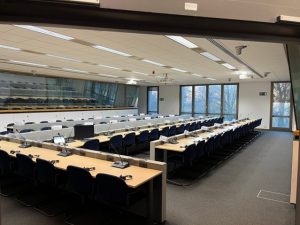And not just “Why”, but also how.
Table of Contents

How do you bring free and open source initiatives and something as regulated as the European Union? Both of these questions triggered me to accept the invitation to travel to Brussels and participate in this day of workshops.
As part of a larger “tribute to open source” that is traditionally happening in this great city, with FOSDEM, a growing interest from the European Union is becoming apparent.
After the keynote address that my CEO Hans-Jürgen Schönig gave at PGConf.EU, just 2 months ago, about digital longevity and the challenge of managing 80 years of critical data, just for one single individual, the necessity and the why were already clear. The additional elements of the “why” emerged throughout the day.
Going back to the opening line of this post, there were practical examples of options around the how, and it is still as vague as this sounds. There are very distinct options to start addressing the how, but we are not there yet. With time, as in many areas, being of the essence, this also is an appeal to our industry as a whole to think about what Hans-Jürgen already thought about.
As a strongly technically oriented company of PostgreSQL enthusiasts and fanatics, it might be strange to sit in with such academic dealings, but pushing your boundaries helps you to see things in a new light.
With 80 to 100 participants gathering in one of the 1,100 meeting rooms that the EU counts, the joint intelligence was only matched by the enthusiasm of the individuals. From the opening statements, the ever-present first goal for open source was clear; the EU needs to reduce their dependency on proprietary technologies. Especially for some of Europe’s most important industries, the automotive industry, this is of essential importance.
Community-governed open-source is the key to the development of open-source solutions. The support for, and interest in open source is rapidly growing. Yes, there is room for proprietary solutions, but the major focus should be on open-source, was the statement of the speaker.
Open source is an industrial differentiator and it is a cornerstone of Europe’s competitive position.
The absence of a natural marketing motion in open source is also prohibiting the spread of software projects. This is part of the nature of how these projects were started and their primary focus, which is to create software and not sell it, let alone explicitly create awareness. Community-governed open-source and well-managed central visibility is a continuous challenge that needs care, attention, and tenacity. Companies like CYBERTEC play a crucial role in this, or at least when it comes to our slide of the cake, which is PostgreSQL.
Cybersecurity is the realm where the European Cyber Resilience Act plays and the consensus was that it did not deal well with the reality of open source. The question is, in general, how the difference between vendor-governed and community-governed open-source is dealt with. You could argue that, in open-source, the software is a by-product of a community activity. There is not a specific vendor that will answer to or act upon government regulations in a specific geographic area. A community might rather decide to simply blacklist a geopolitical area and choose to not be active there.
One of the core questions is how a company positions and identifies itself when it offers a commercial, operational, and legal “layer” over a community-governed open-source project.
A completely different angle on the topic of open-source is shown in the workshop around software-defined vehicles. A 20-year software lifecycle has to be managed as cars have a 20-year-plus lifespan with literally hundreds of software stacks incorporated.
In this case open-source is not just about the license of the software. It is also about how the development governance process is organized and how the software is operated and managed. This becomes very important when thinking about software longevity and the competitive nature of the industry. Someone else might be cutting corners with durability, directly affecting the competitiveness of the software and therefore the resulting car.
Just as an indication of the vastness of what we are talking about, in the automotive industry, an SOP (Start of Production) delay, of one hour creates one million Euro in costs.
In IT, most energy -and therefore the ecological footprint- is created not by compute-resource usage but by data transfer. Local, or as its modern-day name goes, edge-data persistence helps improve the characteristics of this model. My ultimate joy comes from the fact that, even though Mike Stonebraker created Postgres 30 years ago, the server acts as if it was created for just this task.
Another general concern is for us to figure out how to strike the right balance between competition and collaboration in open source. As individuals, as a software industry, but ultimately also as a society. This is a make-or-break topic for the European competitive position when it comes to Asia or the US.
One of the most proficient closing findings of this workshop by Dr. Detlef Zerfowski is that open-source should be much more visible in decision-maker circles. Both higher and middle management should buy into this much-needed change and it is important to help mitigate skepticism.
Even though it was unplanned and unorchestrated, even on such an exclusive level, there is room for PostgreSQL to shine and for CYBERTEC to take a moment in the spotlight.
This workshop is dedicated to successful war stories of open source in practice. For the Austrian National Bank, David Grössing took the stage to discuss ÖNB’s successful journey from their proprietary data management solution to PostgreSQL. The story was emphasized by some very impressive KPIs around financial savings and increased agility for the bank. With a critical role reserved for the CYBERTEC Migrator, in the migration from Oracle to PostgreSQL.
When taking open-source to live projects, “one throat to choke” is a critical success factor in an open-source adoption strategy. Also, the practical adoption of open source is something that needs to navigate the practical limitations of the source vendor lock that has been created. The migration from Oracle to Postgres is a schoolbook example of this.
Another example discussed the success of a connectivity platform based on open source. This depends on strong integration partners, which then translates back to the competitive and collaborative basis we have discussed earlier. In this context I found myself wondering to what extent PostgreSQL is a tool, in the sense that most open-source projects are elements of an IT infrastructure, that are relatively easy to replace. Postgres from that perspective is more of a comprehensive platform than just a tool.
One of the conclusions here is also that organizations should have the guts to put the community at the helm and also let them decide where the project goes. The art becomes then to figure out how to steer the project through influencing circumstantial elements. Another conclusion is that it gets harder and harder to explain that the same software, year after year gets more expensive instead of it getting cheaper.
To sum up:
Data spaces essentially are specific semantic domains that aim to share information on a specific topic across a large group of people. In my current understanding, it combines elements of Master Data Management with a deeper understanding of a specific topic. A good example is public procurement, which accounts for almost 14 percent of Europe’s GDP, a whopping 2 trillion Euro.
The SIMPL consortium is the middleware that will be the backend for dataspaces on a European level, as explained by Eline Lincklaen Arriëns, who is the Communication and Engagement Manager for this recently established project.

Initially, it felt as though I might have taken a wrong turn when I entered the Centre De Conférences Albert Borschette. After going through airport-like security with passport, metal, and X-ray checks, we were allowed to enter the building and find our meeting room. Now, looking back at this complete day -nine hours of information, discussion and interaction can be counted as a full day, even in my book- it is very well spent. I have learned and have gotten confirmed (new) things.
The importance of open-source, the importance of our daily work at CYBERTEC, and the importance of the work our peers, clients, and partners are doing, make a difference in lives. Ultimately, that is what counts! I fully expect next year to be even more invigorating!
Leave a Reply